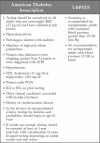An overview of preoperative glucose evaluation, management, and perioperative impact
- PMID: 20144379
- PMCID: PMC2787025
- DOI: 10.1177/193229680900300605
An overview of preoperative glucose evaluation, management, and perioperative impact
Abstract
Perioperative hyperglycemia is a common phenomenon affecting patients both with and without a known prior history of diabetes. Despite an exponential rise in publications and studies of inpatient hyperglycemia over the last decade, many questions still exist as to what defines optimal care of these patients. Initial enthusiasm for tight glycemic control has waned as the unanticipated reality of hypoglycemia and mortality has been realized in some prospective studies. The recent dramatic modification of national practice guidelines to endorse more modest inpatient glycemic targets highlights the dynamic nature of current knowledge as the next decade approaches. This review discusses perioperative hyperglycemia and the categories of patients affected by it. It reviews current recommendations for ambulatory diabetes screening and its importance in preoperative patient care. Finally, it concludes with a review of current practice guidelines, as well as a discussion of future direction and goals for inpatient perioperative glycemic control.
Figures


Similar articles
-
Perioperative and critical illness dysglycemia--controlling the iceberg.J Diabetes Sci Technol. 2009 Nov 1;3(6):1288-91. doi: 10.1177/193229680900300608. J Diabetes Sci Technol. 2009. PMID: 20144382 Free PMC article. Review.
-
Glycemic control in the medical intensive care unit.J Diabetes Sci Technol. 2009 Nov 1;3(6):1330-41. doi: 10.1177/193229680900300613. J Diabetes Sci Technol. 2009. PMID: 20144387 Free PMC article. Review.
-
Glycemic targets in hospital and barriers to attaining them.Can J Diabetes. 2014 Apr;38(2):74-8. doi: 10.1016/j.jcjd.2014.01.001. Can J Diabetes. 2014. PMID: 24690500 Review.
-
Hyperglycemia and perioperative glucose management.Curr Pharm Des. 2012;18(38):6195-203. doi: 10.2174/138161212803832236. Curr Pharm Des. 2012. PMID: 22762467 Free PMC article. Review.
-
Perioperative blood glucose monitoring in the general surgical population.J Diabetes Sci Technol. 2009 Nov 1;3(6):1282-7. doi: 10.1177/193229680900300607. J Diabetes Sci Technol. 2009. PMID: 20144381 Free PMC article. Review.
Cited by
-
Patients With Type 2 Diabetes: Anesthetic Management in the Ambulatory Setting. Part 1: Pathophysiology and Associated Disease States.Anesth Prog. 2016 Winter;63(4):208-215. doi: 10.2344/0003-3006-63.4.208. Anesth Prog. 2016. PMID: 27973934 Free PMC article. Review.
-
Medical complications of obesity and optimization of the obese patient for colorectal surgery.Clin Colon Rectal Surg. 2011 Dec;24(4):211-21. doi: 10.1055/s-0031-1295693. Clin Colon Rectal Surg. 2011. PMID: 23204936 Free PMC article.
-
Management of hyperglycemia during the perioperative period.Curr Diab Rep. 2012 Feb;12(1):108-18. doi: 10.1007/s11892-011-0239-2. Curr Diab Rep. 2012. PMID: 22086363 Review.
-
[Expert consensus on the implementation of enhanced recovery after surgery in percutaneous endoscopic interlaminar lumbar decompression/discectomy (2020)].Zhongguo Xiu Fu Chong Jian Wai Ke Za Zhi. 2020 Dec 15;34(12):1497-1506. doi: 10.7507/1002-1892.202011021. Zhongguo Xiu Fu Chong Jian Wai Ke Za Zhi. 2020. PMID: 33319526 Free PMC article. Review. Chinese.
-
Impact of diabetes mellitus on postoperative outcomes in individuals with non-small-cell lung cancer: A retrospective cohort study.PLoS One. 2020 Nov 9;15(11):e0241930. doi: 10.1371/journal.pone.0241930. eCollection 2020. PLoS One. 2020. PMID: 33166327 Free PMC article.
References
-
- Clement S, Braithwaite SS, Magee MF, Ahmann A, Smith EP, Schafer RG, Hirsch IB American Diabetes Association Diabetes in Hospitals Writing Committee. Management of diabetes and hyperglycemia in hospitals. Diabetes Care. 2004;27(2):553–591. - PubMed
-
- Umpierrez GE, Isaacs SD, Bazargan N, You X, Thaler LM, Kitabchi AE. Hyperglycemia: an independent marker of in-hospital mortality in patients with undiagnosed diabetes. J Clin Endocrinol Metab. 2002;87(3):978–982. - PubMed
-
- Cowie CC, Rust KF, Byrd-Holt DD, Eberhardt MS, Flegal KM, Engelgau MM, Saydah SH, Williams DE, Geiss LS, Gregg EW. Prevalence of diabetes and impaired fasting glucose in adults in the U.S. population: National health and Nutrition examination Survey 1999-2002. Diabetes Care. 2006;29(6):1263–1268. - PubMed
-
- American Diabetes Association. Incidence and prevalence [cited 2009 May 21]. Available from: http://professional.diabetes.org/Disease_Backgrounder.aspx?TYP=6&MID=236.
Publication types
MeSH terms
Substances
LinkOut - more resources
Full Text Sources
Medical

